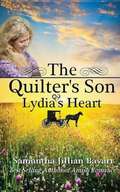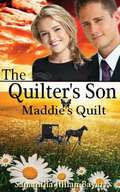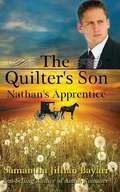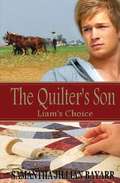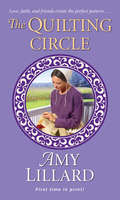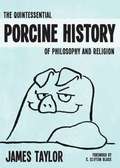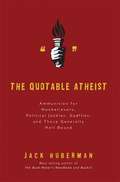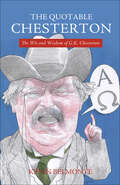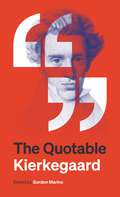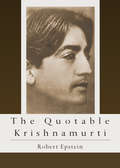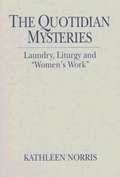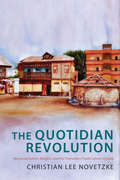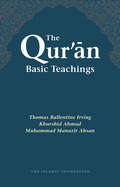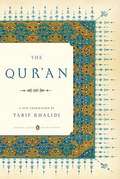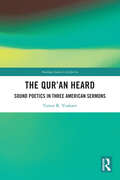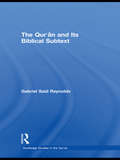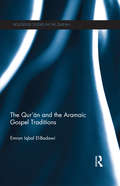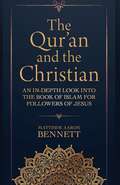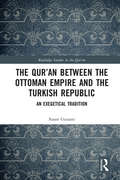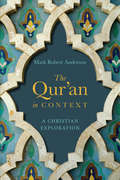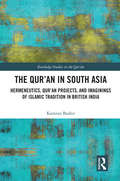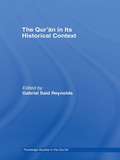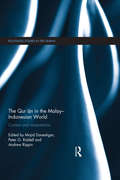- Table View
- List View
The Quilter's Son: Lydia's Heart (The Quilter's Son #2)
by Samantha BayarrAfter rejecting the baptism into the Amish faith, Lydia Yoder has spent the past year courting Englischer, Steven Miller. When a mistake from Steve's past threatens to prevent their wedding, Lydia begins to contemplate joining the Amish community she'd turned her back on. Will Lydia be able to look past a mistake her betrothed made in his youth and open her heart to forgiveness, or is her heart broken beyond repair?
The Quilter's Son: Maddie's Quilt (The Quilter's Son #4)
by Samantha BayarrBook Four in The Quilter's Son seriesMaddie Hayes comes home early from college after being forced to leave her cheerleading scholarship behind. When Anna learns Maddie's secret, she discovers they have more in common than she originally thought. Anna and Maddie become roommates until Anna unexpectedly moves out and leaves Nathan just days before their wedding. Will Nathan be able to put his own worries aside to help Maddie through her dilemma?Find out in this tale of lost and found love. . .
The Quilter's Son: Nathan's Apprentice (The Quilter's Son #3)
by Samantha BayarrNathan had steered his life in one direction since his youth: toward a future with Anna as his wife. But when his desires for an alternate future threaten that, he must choose the right path. Enter Maddie, the pretty cheerleader, who accompanies Nathan on a tour of the university they had both been accepted to, and his future path veers off into a direction that spins out of control. Can Nathan get back on the path toward his future with Anna, or is something else in store for him?
The Quilter’s Son: Liam’s Choice (The Quilter's Son #1)
by Samantha BayarrLiam Yoder has been leading a double life ever since his dad was killed in a buggy accident. Will a chance encounter with his mother cause him to rethink his decision to leave the Amish community behind? What about Lucy, the bakery owner he left behind when they were teenagers? Will she be able to convince Liam to change his mind?Find out in this tale of bittersweet love. . .
The Quilting Circle (A Wells Landing Romance #7)
by Amy LillardUnited by faith, and bonded by their quilting circle, the Amish women of Wells Landing, Oklahoma, are there for one another through all life’s joys and challenges . . . MORE THAN FRIENDSHIP Youngest quilter Clara Rose Yutzy is planning her wedding to her longtime beau—which is why she resolutely ignores newly warm feelings for her best friend, Obidiah. But Obie is certain God intends them to be together. With the Lord’s help, he’ll prove to Clara Rose how much he loves her . . . MORE THAN A PROMISE Mariana Miller prayed for a child throughout fifteen years of marriage. But now, newly widowed, Mariana discovers she’s pregnant—with twins! She’s more grateful than ever for her caring community—especially Reuben Weisel, her late husband’s business partner and best friend. Reuben’s quiet strength comforts her—until he proposes marriage . . . MORE THAN A MARRIAGE Tess Smiley is new to Wells Landing and newly married. But her marriage isn’t the harmonious union she envisioned. Tess loves Jacob with all her heart, but her heart tells her she must take a stand—and ask for support. Only then does Jacob see how he has hurt her. But is he too late? . . .
The Quintessential Porcine History of Philosophy and Religion
by James TaylorWith delightful disrespect and hilarious updated illustrations, the author takes you through the history of Western philosophy and religion. Beginning with classic Greek pigs, the author pokes good-natured fun as you learn the essentials of these most important thinkers and schools of thought. See a little band of Methodist pigs fleeing from the wrath to come, a Calvinist pig being saved because he is predestined to be among the elect, a Barthian Pig hearing a resounding “NO” from above, a Deconstuctionist pig interpreting a text, and many others.
The Quotable Atheist: Ammunition for Nonbelievers, Political Junkies, Gadflies, and Those Generally Hell-bound
by Jack HubermanSurprisingly, no book of quotations on God and religion by atheists and agnostics exists. Luckily, for the millions of American nonbelievers who have quietly stewed for years as the religious right made gains in politics and culture, the wait is over.
The Quotable Chesterton: The Wit and Wisdom of G. K. Chesterton
by Kevin BelmonteG. K. Chesterton was a literary giant of his age. With an exceptional intellect, he wrote about history, politics, economics, philosophy, social and literary criticism, and theology. He published essays, novels, biographies, short stories, and poetry, and the Christian classics Heretics, Orthodoxy, and The Everlasting Man, which C. S. Lewis credits as instrumental in his conversion to Christianity.With much of his finest material out of print or hard to find, modern readers have long needed a standard collection of his best thoughts. Kevin Belmonte’s The Quotable Chesterton brings them to you arranged alphabetically by topic, with complete original source documentation.There are entries from Adventure to Cheese, Politics to Émile Zola, interspersed with essays about Chesterton’s life and times. Hundreds of passages drawn from Chesterton’s fiction, poetry, essays, and other books showcase a man the New York Times hailed as a “brilliant English essayist” and George Bernard Shaw called a “colossal genius.”Endorsements:“There isn’t a writer who gets me pacing and smiling and thinking like G.K. Chesterton. His every paradigm shift is an adjustment to my mental compass, and so a gift.” —DONALD MILLER, author of the New York Times bestsellers A Million Miles in a Thousand Years and Blue Like Jazz“Over the years, I have delivered thousands of lectures, speeches, talks, and sermons; I have written hundreds of articles, essays, books, and reviews; it is an exceedingly rare occasion when any of them should fail to contain the words ‘Chesterton once said.’ Kevin Belmonte here reveals that fountain of wit, wisdom, and wonder, G.K. Chesterton, in all his irresistibly, irrepressibly, quotable splendor.”—GEORGE GRANT, Pastor, Parish Presbyterian Church, and Chancellor, New College Franklin
The Quotable Kierkegaard
by Søren KierkegaardThe most comprehensive and authoritative collection of Kierkegaard quotations ever published"Why I so much prefer autumn to spring is that in the autumn one looks at heaven—in the spring at the earth."—Søren KierkegaardThe father of existentialism, Søren Kierkegaard (1813-1855) was a philosopher who could write like an angel. With only a sentence or two, he could plumb the depths of the human spirit. In this collection of some 800 quotations, the reader will find dazzling bon mots next to words of life-changing power. Drawing from the authoritative Princeton editions of Kierkegaard's writings, this book presents a broad selection of his wit and wisdom, as well as a stimulating introduction to his life and work.Organized by topic, this volume covers notable Kierkegaardian concerns such as anxiety, despair, existence, irony, and the absurd, but also erotic love, the press, busyness, and the comic. Here readers will encounter both well-known quotations ("Life must be understood backward. But then one forgets the other principle, that it must be lived forward") and obscure ones ("Beware false prophets who come to you in wolves' clothing but inwardly are sheep—i.e., the phrasemongers"). Those who spend time in these pages will discover the writer who said, "my grief is my castle," but who also taught that "the best defense against hypocrisy is love."Illuminating and delightful, this engaging book also provides a substantial portrait of one of the most influential of modern thinkers.Gathers some 800 quotationsDrawn from the authoritative Princeton editions of Kierkegaard's writingsIncludes an introduction, a brief account and timeline of Kierkegaard's life, a guide to further reading, and an index
The Quotable Krishnamurti
by Robert EpsteinTruth is a pathless land; you cannot approach it by any religion. . . . My only concern is to set men absolutely free. So said Jiddu Krishnamurti, one of the most influential spiritual leaders of the twentieth century. Born in India in 1905, as a teenager he was groomed by Theosophists C. W. Leadbeater and Annie Besant to become the next World Teacher. Yet later he broke from his mentors, refusing to play the messiah. For decades he traveled the globe, urging his followers to pursue their own, individual freedom without dependence on any doctrine. Hence this book's guiding purpose. Author Robert Epstein culls key quotations from Krishnamurti's Commentaries on Living and other works. Conveniently organized from A to Z, topics range from acceptance and anger to consciousness, fear, fulfillment, God, hope, joy, love, nonviolence, reincarnation, relationship, self-understanding, sex, suffering, vegetarianism, war, and wisdom. "You are the world, and the world is you," said Krishnamurti. "If there is a radical transformation in the structure of an individual's psyche, it will affect the whole consciousness of man." This small jewel of a book contains enormous power to inspire readers to just such a change.
The Quotable Krishnamurti
by Robert EpsteinTruth is a pathless land; you cannot approach it by any religion. . . . My only concern is to set men absolutely free. So said Jiddu Krishnamurti, one of the most influential spiritual leaders of the twentieth century. Born in India in 1905, as a teenager he was groomed by Theosophists C. W. Leadbeater and Annie Besant to become the next World Teacher. Yet later he broke from his mentors, refusing to play the messiah. For decades he traveled the globe, urging his followers to pursue their own, individual freedom without dependence on any doctrine. Hence this book's guiding purpose. Author Robert Epstein culls key quotations from Krishnamurti's 'Commentaries on Living' and other works. Conveniently organized from A to Z, topics range from acceptance and anger to consciousness, fear, fulfillment, God, hope, joy, love, nonviolence, reincarnation, relationship, self-understanding, sex, suffering, vegetarianism, war, and wisdom. "You are the world, and the world is you," said Krishnamurti. "If there is a radical transformation in the structure of an individual's psyche, it will affect the whole consciousness of man." This small jewel of a book contains enormous power to inspire readers to just such a change.
The Quotidian Mysteries: Laundry, Liturgy and "Women's Work"
by Kathleen NorrisAuthor discusses the spiritual aspects of daily household chores, and the ramifications for women's spirituality.
The Quotidian Revolution: Vernacularization, Religion, and the Premodern Public Sphere in India
by Christian Lee NovetzkeIn thirteenth-century Maharashtra, a new vernacular literature emerged to challenge the hegemony of Sanskrit, a language largely restricted to men of high caste. In a vivid and accessible idiom, this new Marathi literature inaugurated a public debate over the ethics of social difference grounded in the idiom of everyday life. The arguments of vernacular intellectuals pushed the question of social inclusion into ever-wider social realms, spearheading the development of a nascent premodern public sphere that valorized the quotidian world in sociopolitical terms.The Quotidian Revolution examines this pivotal moment of vernacularization in Indian literature, religion, and public life by investigating courtly donative Marathi inscriptions alongside the first extant texts of Marathi literature: the Lilacaritra (1278) and the Jñanesvari (1290). Novetzke revisits the influence of Chakradhar (c. 1194), the founder of the Mahanubhav religion, and Jnandev (c. 1271), who became a major figure of the Varkari religion, to observe how these avant-garde and worldly elites pursued a radical intervention into the social questions and ethics of the age. Drawing on political anthropology and contemporary theories of social justice, religion, and the public sphere, The Quotidian Revolution explores the specific circumstances of this new discourse oriented around everyday life and its lasting legacy: widening the space of public debate in a way that presages key aspects of Indian modernity and democracy.
The Qur' n Basic Teachings
by Khurshid Ahmad Thomas Ballantine Irving Muhammad Manazir AhsanAn anthology of selections from the Qur'an in contemporary English on topics ranging from the story of Creation and the idea of God to politics and economics. Compiled by three scholars, including T. B. Irving, the first American to translate the Qur'an into English, with a helpful introduction, extensive glossary and an index of Qur'anic verses.
The Qur'an
by Tarif KhalidiA landmark new translation of the sacred text of Islam? in an elegant deluxe edition Literally ?the recitation,? The Qur?an is considered within the Muslim faith to be the infallible word of God. Tarif Khalidi, the foremost scholar of Islamic history and faith, provides a fresh English translation that captures the startling, exquisite poetry of one of the world?s most beloved religious texts. Retaining the structure and rhythms of the original Arabic, Khalidi enlivens the ancient teachings and prophetic narratives central to the Muslim faith and solidifies The Qur?an as a work of spiritual authority and breathtaking beauty. A landmark new translation of the sacred text of Islam? in an elegant deluxe edition Literally ?the recitat ion,? The Qur?an is considered within the Muslim faith to be the infallible word of God. Tarif Khalidi, the foremost scholar of Islamic history and faith, provides a fresh English translation that captures the startling, exquisite poetry of one of the world?s most beloved religious texts. Retaining the structure and rhythms of the original Arabic, Khalidi enlivens the ancient teachings and prophetic narratives central to the Muslim faith and solidifies The Qur?an as a work of spiritual authority and breathtaking beauty. .
The Qur'an Heard: Sound Poetics in Three American Sermons (Routledge Studies in the Qur'an)
by Timur R. YuskaevFor many Muslims, there is an inseparable connection between sound and meaning, particularly when it comes to Islamic verse and scripture. This provides fertile ground for a comparative study across traditions and forms. Timur Yuskaev offers a meditation on the Qur’an and human sensibilities, heard together, in American Muslim sermons. Foregrounding sound, poetry and music, it is a cultural anthropology of the Qur’an, carried out in conversation with colleagues in multiple disciplines, including Religions in America, Qur’anic, Islamic, Memory, Communication, and Sound Studies. The author draws upon the works of Mikhail Bakhtin, Charles Long, Mary Douglas and many others to hear mysticism in a homiletic symphony by Warith Deen Mohammed, to sense the experience of the covenant in a three-minute, ribbon-cutting speech by Aras Konjhodzic, and to appreciate the Qur’anic musicality of a down-to-earth interfaith address by Sarah Sayeed. A creative guide to an organic engagement with texts, this book will be of particular interest to those studying scriptures and the Qur’an.
The Qur'an and its Biblical Subtext (Routledge Studies in the Qur'an)
by Gabriel Said ReynoldsThis book challenges the dominant scholarly notion that the Qur’ān must be interpreted through the medieval commentaries shaped by the biography of the prophet Muhammad, arguing instead that the text is best read in light of Christian and Jewish scripture. The Qur’ān, in its use of allusions, depends on the Biblical knowledge of its audience. However, medieval Muslim commentators, working in a context of religious rivalry, developed stories that separate Qur’ān and Bible, which this book brings back together. In a series of studies involving the devil, Adam, Abraham, Jonah, Mary, and Muhammad among others, Reynolds shows how modern translators of the Qur’ān have followed medieval Muslim commentary and demonstrates how an appreciation of the Qur’ān’s Biblical subtext uncovers the richness of the Qur’ān’s discourse. Presenting unique interpretations of 13 different sections of the Qur’ān based on studies of earlier Jewish and Christian literature, the author substantially re-evaluates Muslim exegetical literature. Thus The Qur’ān and Its Biblical Subtext, a work based on a profound regard for the Qur’ān’s literary structure and rhetorical strategy, poses a substantial challenge to the standard scholarship of Qur’ānic Studies. With an approach that bridges early Christian history and Islamic origins, the book will appeal not only to students of the Qur’an but of the Bible, religious studies and Islamic history.
The Qur'an and the Aramaic Gospel Traditions (Routledge Studies in the Qur'an)
by Emran El-BadawiThis book is a study of related passages found in the Arabic Qur’ān and the Aramaic Gospels, i.e. the Gospels preserved in the Syriac and Christian Palestinian Aramaic dialects. It builds upon the work of traditional Muslim scholars, including al-Biqā‘ī (d. ca. 808/1460) and al-Suyūṭī (d. 911/1505), who wrote books examining connections between the Qur’ān on the one hand, and Biblical passages and Aramaic terminology on the other, as well as modern western scholars, including Sidney Griffith who argue that pre-Islamic Arabs accessed the Bible in Aramaic. The Qur’ān and the Aramaic Gospel Traditions examines the history of religious movements in the Middle East from 180-632 CE, explaining Islam as a response to the disunity of the Aramaic speaking churches. It then compares the Arabic text of the Qur’ān and the Aramaic text of the Gospels under four main themes: the prophets; the clergy; the divine; and the apocalypse. Among the findings of this book are that the articulator as well as audience of the Qur’ān were monotheistic in origin, probably bilingual, culturally sophisticated and accustomed to the theological debates that raged between the Aramaic speaking churches. Arguing that the Qur’ān’s teachings and ethics echo Jewish-Christian conservatism, this book will be of interest to students and scholars of Religion, History, and Literature.
The Qur'an and the Christian: An In-Depth Look into the Book of Islam for Followers of Jesus
by Matthew Aaron BennettUnderstanding Islam's sacred text is integral to understanding your Muslim neighbor Cross-cultural missionary and scholar Matthew Aaron Bennett blends the insights of Islamic believers, secular Qur'an scholars, and missionaries to Muslims, making The Qur'an and the Christian like no other resource for Christian ministry to Muslims. Combining these perspectives in one guide better equips Christians to communicate the biblical gospel to friends and neighbors who are adherents to Islam--both in and out of majority-Muslim cultures.The Qur'an and the Christian addresses issues both simple and profound, such as:• How the Qur'an came to be, including Muhammed and the Qur'an's textual precursors• The major themes of the Qur'an and how these shape the practice of Islam• The presence of Bible characters, Jews, and Christians in the Qur'anic text• Whether and how a Christian should read the Qur'an• Avoiding miscommunication with Muslims when the Qur'an and Christian teaching seem to overlapThis book will help Christians learn how to explore Islamic faith with missiological wisdom and biblical precision. The Qur'an and the Christian will give believers the insight to deepen friendships, promote understanding, and clarify the biblical gospel among Muslim friends and neighbors.
The Qur'an between the Ottoman Empire and the Turkish Republic: An Exegetical Tradition (Routledge Studies in the Qur'an)
by Susan GunastiThe Qur’an between the Ottoman Empire and the Turkish Republic is one of the few book-length studies on an Ottoman Qur’an commentary. Its premise is that "the Ottoman Empire" did not come to an end until 1950 so far as Islam was concerned in Turkey. The work explores the relationship between Elmalılı’s Qur’an commentary and the intellectual trends of the period, including the impact of materialism, the sciences, notions of civilizational progress, and philosophy. In doing so, this study emphasizes the "local" aspect of the Qur’an commentary, through a sustained focus on the Istanbul context in which it was written. This work demonstrates that Elmalılı’s Qur’an commentary is a product of and reaction to the religious, intellectual, political, and social trends of the period. This work, in considering all the factors that led to the commissioning of Elmalılı’s Qur’an commentary, also contributes to our understanding of the history of Islam in early to mid-twentieth-century Turkey. This intellectual history of modern Islamic thought contributes to our understanding of the genre of Qur’an commentary in the early twentieth century. It is a key text for students and scholars interested in Islam in the Ottoman Empire and Turkey, modern Islamic thought, and the Middle East.
The Qur'an in Christian-Muslim Dialogue: Historical and Modern Interpretations (Culture and Civilization in the Middle East)
by Corrie BlockOffering an analysis of Christian-Muslim dialogue across four centuries, this book highlights those voices of ecumenical tone which have more often used the Qur’an for drawing the two faiths together rather than pushing them apart, and amplifies the voice of the Qur’an itself. Finding that there is tremendous ecumenical ground between Christianity and Islam in the voices of their own scholars, this book ranges from a period of declining ecumenism during the first three centuries of Islam, to a period of resurging ecumenism during the most recent century until now. Among the ecumenical voices in the Christian-Muslim dialogue, this book points out that the Qur’an itself is possibly the strongest of those voices. These findings are cause for, and evidence of, hope for the Christian–Muslim relationship: that although agreement may never be reached, dialogue has led at times to very real mutual understanding and appreciation of the religious other. Providing a tool for those pursuing understanding and mutual appreciation between the Islamic and Christian faiths, this book will be of interest to scholars and students of Islam, the Qur’an and the history of Christian-Muslim relations.
The Qur'an in Context: A Christian Exploration
by Mark Robert AndersonFor Westerners the Qur'an is a deeply foreign book. Christians who venture within this sacred scripture of Islam encounter a world where echoes of biblical figures and themes resound. But the Qur'an speaks in accents and forms that defy our expectations. For it captures an oral recitation of an open-ended drama, one rooted in seventh-century Arabia. Its context of people, events and ideas strikes us not only as poetically allusive but as enigmatic. And yet the Qur'an and its contested interpretations scroll in shadowed text between the headlines of our daily news. In The Qur'an in Context Mark Anderson offers a gateway into the original world and worldview of the Qur'an. With keen attention to the Qur'an's character, reception and theology, he opens up a hermeneutical space for Christians and others to engage its fabric of religious claims. The Qur'an's theology, anthropology, soteriology, spirituality as well as its portrayal of Jesus are all carefully examined. Finally, the Qur'an's claim to be the Bible's sequel is probed and evaluated. Forthright in Christian conviction and yet sympathetically open to dialogue, The Qur'an in Context is a reliable guide for those who want to explore the holy book of Islam in its varied facets.
The Qur'an in South Asia: Hermeneutics, Qur'an Projects, and Imaginings of Islamic Tradition in British India (Routledge Studies in the Qur'an)
by Kamran BashirThe book investigates modern Qur’an commentaries in South Asia and engages with how Muslim scholars have imagined and assessed their past intellectual heritage. The research is focused on British India from the time of the Mutiny of 1857 to the moment of the Partition of united India in 1947. Offering critical scrutiny of Muslim exegesis of the Qur’an in North India, the study especially focuses on the Qur’anic thought of Sayyid Ahmed Khan (d. 1989), Ashraf Ali Thanawi (d. 1943), and Hamid al-Din Farahi (d. 1930). The volume challenges widespread assumptions of an all-pervasive reform and revivalism underlying the academic study of Islam. Instead of looking for Muslim revivalism and reform as epistemological foundations, it stresses the study of modern Qur’an commentaries, in particular local and cosmopolitan contexts. Departing from the oft-repeated explanations of Muslim scholarship and modern Islam through the lens of traditionalism and modernism, it discovers how Muslim scholars viewed themselves in relation to the Islamic tradition, and how they imagined and assessed their past intellectual heritage. Studying the history of the interpretation of the Qur’an in the multiple contexts of nineteenth and early twentieth-century British India, the book will be of interest to readers of Qur’anic studies, modern Islam and South Asian studies.
The Qur'an in its Historical Context (Routledge Studies in the Qur'an)
by Gabriel Said ReynoldsProviding commentary on the controversial revisionist school of Qur’anic studies, this book explores the origins, scholarship and development of the Qur'an. The collection of articles, each written by a distinguished author, treat very familiar passages of the Qur’an in an original manner, combining thorough philology, historical anthropology, and cultural history. This book addresses in a critical fashion the hottest issues in recent works on the Quran. Among other things, the contributors analyze the controversial theories of Luxenberg regarding Syriac and the Quran, and in particular his argument that the term Hur refers not to virgins but to grapes.
The Qur'an in the Malay-Indonesian World: Context and Interpretation (Routledge Studies in the Qur'an)
by Andrew Rippin Majid Daneshgar Peter G. RiddellThe largely Arabo-centric approach to the academic study of tafsir has resulted in a lack of literature exploring the diversity of Qur'anic interpretation in other areas of the Muslim-majority world. The essays in The Qur'an in the Malay-Indonesian World resolve this, aiming to expand our knowledge of tafsir and its history in the Malay-Indonesian world. Highlighting the scope of Qur'anic interpretation in the Malay world in its various vernaculars, it also contextualizes this work to reveal its place as part of the wider Islamic world, especially through its connections to the Arab world, and demonstrates the strength of these connections. The volume is divided into three parts written primarily by scholars from Malaysia and Indonesia. Beginning with a historical overview, it then moves into chapters with a more specifically regional focus to conclude with a thematic approach by looking at topics of some controversy in the broader world. Presenting new examinations of an under-researched topic, this book will be of interest to students and scholars of Islamic studies and Southeast Asian studies.
